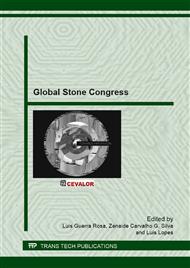p.189
p.197
p.205
p.212
p.220
p.231
p.239
p.247
p.255
Comparison of Young’s Moduli of Engineered Stones Using Different Test Methods
Abstract:
This work reports the results of Young’s modulus of elasticity obtained for 3 types of engineered stones. Using parallelepiped specimens with dimensions 150 30 20 mm3, Young’s modulus is determined by different methods: static and dynamic. Via quasi-static deformation tests: - uniaxial tension, - uniaxial compression, and, - pure bending (i.e. symmetrical four-point bending), determination of Young’s modulus was carried out by means of the conventional electric-resistance extensometry with strain-gauge strips glued to the specimens. The results obtained from these quasi-static deformation tests are compared with the results of dynamic Young’s modulus obtained with RFDA equipment (Resonant Frequency & Damping Analyser) using the parallelepiped specimens in a flexural vibration mode. Dynamic Young’s modulus was also evaluated through measurements of ultrasonic pulses velocity. Composition and microstructures of the materials under investigation are also presented and discussed.
Info:
Periodical:
Pages:
220-230
Citation:
Online since:
April 2013
Price:
Сopyright:
© 2013 Trans Tech Publications Ltd. All Rights Reserved
Share:
Citation:


